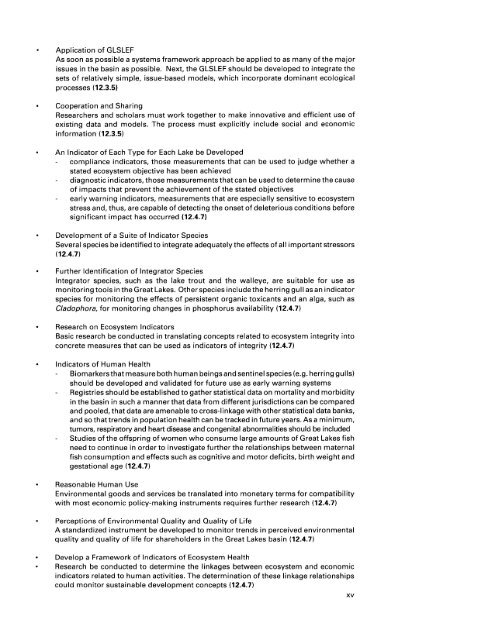International Joint Commission
International Joint Commission
International Joint Commission
You also want an ePaper? Increase the reach of your titles
YUMPU automatically turns print PDFs into web optimized ePapers that Google loves.
Application of GLSLEF<br />
As soon as possible a systems framework approach be applied to as many of the major<br />
issues in the basin as possible. Next, the GLSLEF should be developed to integrate the<br />
sets of relatively simple, issue-based models, which incorporate dominant ecological<br />
processes (12.3.5)<br />
Cooperation and Sharing<br />
Researchers and scholars must work together to make innovative and efficient use of<br />
existing data and models. The process must explicitly include social and economic<br />
information (12.3.5)<br />
An Indicator of Each Type for Each Lake be Developed<br />
- compliance indicators, those measurements that can be used to judge whether a<br />
stated ecosystem objective has been achieved<br />
- diagnostic indicators, those measurements that can be used to determine the cause<br />
of impacts that prevent the achievement of the stated objectives<br />
- early warning indicators, measurements that are especially sensitive to ecosystem<br />
stress and, thus, are capable of detecting the onset of deleterious conditions before<br />
significant impact has occurred (12.4.7)<br />
Development of a Suite of Indicator Species<br />
Several species be identified to integrate adequately the effects of all important stressors<br />
(12.4.7)<br />
Further Identification of Integrator Species<br />
Integrator species, such as the lake trout and the walleye, are suitable for use as<br />
monitoring tools in the Great Lakes. Other species include the herring gull as an indicator<br />
species for monitoring the effects of persistent organic toxicants and an alga, such as<br />
Cladophora, for monitoring changes in phosphorus availability (12.4.7)<br />
Research on Ecosystem Indicators<br />
Basic research be conducted in translating concepts related to ecosystem integrity into<br />
concrete measures that can be used as indicators of integrity (12.4.7)<br />
Indicators of Human Health<br />
- Biomarkersthat measure both human beingsand sentinel species(e.g. herring gulls)<br />
should be developed and validated for future use as early warning systems<br />
- Registries should be established to gather statistical data on mortality and morbidity<br />
in the basin in such a manner that data from different jurisdictions can be compared<br />
and pooled, that data are amenable to cross-linkage with other statistical data banks,<br />
and so that trends in population health can be tracked in future years. As a minimum,<br />
tumors, respiratory and heart disease and congenital abnormalities should be included<br />
- Studies of the offspring of women who consume large amounts of Great Lakes fish<br />
need to continue in order to investigate further the relationships between maternal<br />
fish consumption and effects such as cognitive and motor deficits, birth weight and<br />
gestational age (12.4.7)<br />
Reasonable Human Use<br />
Environmental goods and services be translated into monetary terms for compatibility<br />
with most economic policy-making instruments requires further research (12.4.7)<br />
Perceptions of Environmental Quality and Quality of Life<br />
A standardized instrument be developed to monitor trends in perceived environmental<br />
quality and quality of life for shareholders in the Great Lakes basin (12.4.7)<br />
Develop a Framework of Indicators of Ecosystem Health<br />
Research be conducted to determine the linkages between ecosystem and economic<br />
indicators related to human activities. The determination of these linkage relationships<br />
could monitor sustainable development concepts (12.4.7)<br />
xv

















